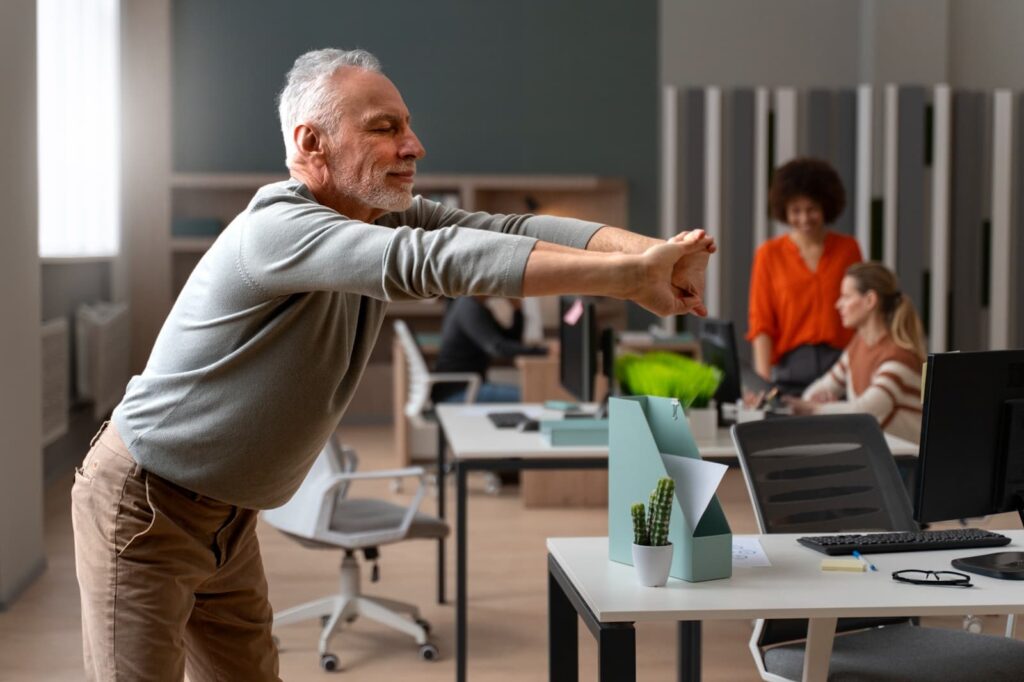We’ve all heard about the importance of ergonomic desk setups and quick office breaks. But what about the other 16 hours of the day? Our bodies don’t just “turn off” their needs when we leave the office chair. From lifting boxes to standing in line, walking through a hospital corridor, or even relaxing at home, how we move and hold ourselves throughout the entire day profoundly impacts our energy, comfort, and long-term health.
This blog entry takes you beyond the chair, guiding you through the essential principles of sustained movement and postural awareness. It’s about building a holistic understanding of how your body works, enabling you to reduce strain, prevent musculoskeletal disorders (MSDs), and maintain peak productivity and well-being, not just at your desk, but in every moment of your busy day.
The Holistic Approach: Why All-Day Movement Matters
For healthcare professionals, administrative leads, and support staff, the demands extend far beyond sitting. Constant transitions between sitting, standing, walking, and sometimes lifting, highlight the need for a comprehensive approach to body mechanics. Embracing all-day movement and postural awareness is crucial for:

- Continuous MSD Prevention: Reduces chronic strain and injury risk from everyday activities, not just desk work.
- Sustained Energy Levels: Keeps circulation flowing and muscles engaged, preventing afternoon slumps and fatigue.
- Enhanced Physical Resilience: Stronger, more flexible bodies are less prone to injury and recover faster.
- Improved Focus and Mental Clarity: A comfortable body allows for greater concentration on tasks, whether administrative or patient-facing.
- Optimized Overall Well-being: Contributes to better sleep, reduced stress, and a higher quality of life, boosting morale and reducing absenteeism.
Your All-Day Movement Playbook: Practical Tips for Every Scenario
Integrating movement and postural awareness into your entire day is simpler than you think. It’s about mindful habits.
- Awake & Aware: Starting Your Day Right
- Gentle Wake-Up Stretches: Before even getting out of bed, do some gentle stretches (e.g., knee-to-chest, spinal twists) to prepare your body.
- Mindful Standing: Whether waiting for coffee or brushing your teeth, practice standing tall: shoulders back and down, core gently engaged, weight evenly distributed.
- On the Move: Walking, Lifting, and Carrying
- The Power Walk: When walking (e.g., to a meeting, fetching documents), engage your core, swing your arms naturally, and maintain an upright posture.
- Lift with Your Legs: For any lifting (even light boxes), squat down, keep your back straight, engage your core, and let your powerful leg muscles do the work. Avoid bending at the waist.
- Balanced Carrying: If carrying bags or files, distribute weight evenly between both hands or use a backpack to balance the load across your shoulders. Avoid consistently carrying heavy items on one side.
- Beyond the Desk: Non-Sedentary Work and Breaks
- Active Meetings: Suggest “walking meetings” or stand for part of a long meeting.
- Breaks, Reimagined: Use lunch breaks for a brisk walk. Opt for stairs over elevators. Park further away to get extra steps.
- Standing Workstations: Utilize standing desks if available, gradually increasing standing time. Even standing for phone calls can make a difference.
- Evening Unwind: Preparing for Rest
- Conscious Relaxation: When sitting on the couch or reading, be mindful of your posture. Avoid slumping; use cushions for support.
- Gentle Evening Stretches: Incorporate light stretching or a short yoga routine to release tension from the day and prepare for restful sleep.
Cultivating Postural Awareness: A Mind-Body Connection
True postural awareness isn’t about stiffness; it’s about dynamic stability. It means feeling where your body is in space and making micro-adjustments. Regularly check in with yourself:
- Are my shoulders hunched?
- Is my neck strained?
- Am I slouching while texting?
- Am I favoring one side when standing?
These simple checks can prevent habits that lead to chronic pain and fatigue.
A Healthier Team, A More Productive Practice
For healthcare organizations, promoting this holistic view of movement and postural awareness isn’t just about individual well-being; it’s about cultivating a resilient, high-performing workforce. Staff who are free from chronic pain and energized throughout their day are more focused, less prone to burnout, and more capable of delivering exceptional patient care and administrative support. It translates directly to better operational efficiency and a more vibrant workplace culture.
Ready to empower your team with a deeper understanding of movement and well-being, fostering a more productive and pain-free environment? Access-Salud provides comprehensive wellness solutions and expert guidance to help your healthcare professionals thrive.





